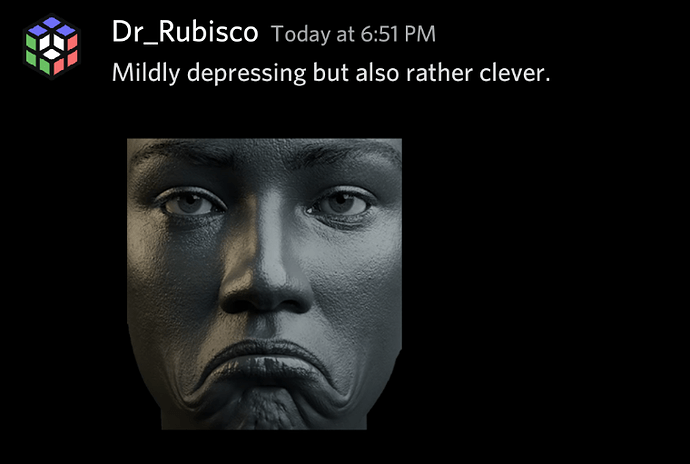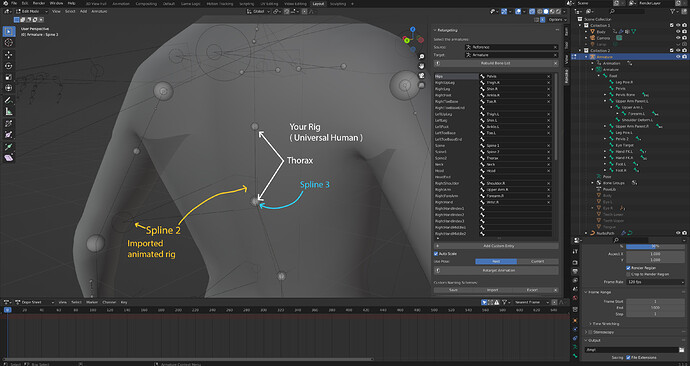I just wanted to know if you are going to show us more of those great renders ![]()
Chris, be honest… did you design reality??? That is completely insane, it is fully photoreal! How well does it animate?!?
When I typed a response on Discord Mobile earlier, This popped up as a recommended sticker and I couldn’t help but smile and think of Chris ![]()
You’re changing the world more than you know. Keep up the great work! ![]()
Hi, I just bought skin shader and face textures but I didn’t figure out the skin shader. Why there is not skin textures. Just a 3 mb blender file. Need help.
How well does it animate?!?
That’s largely down to the animator I guess.
This popped up as a recommended sticker
Heh!
I didn’t figure out the skin shader. Why there is not skin textures. Just a 3 mb blender file. Need help.
You need to append the skin material and add the face textures to the image nodes (see the Skin Shader and Face Textures documentation).
I’ve append the skin material as following instructions documentation. But there is no skin textures in the file right? Is skin shader procedural or something?
Face maps are ok.
The Skin Shader doesn’t contain image textures, that’s what the Face Textures are for. Did you go through the steps for appending as well as the ones for adding the textures? Send me an email if you’re still stuck.
i checked out all of the products on the website and it’s all so cool! when i rack up enough money, i’ll definitely buy everything i’ll need for a head ![]()
Hi Chris amazing work so far! I’ve been playing around with the rig, in extreme poses the wrist looks elastic and the top of the feet is bunching out a bit much. Would be really nice if it was possible to curve the feet, keep up the beautiful works!
Yeah extreme poses do tend to bring issues out of the woodwork. The feet are perhaps the least refined part of the model, since they’re basically placeholders for shoes… hence why they only have limited articulation (which isn’t to say they’ll stay that way necessarily).
The wrist might get some more attention when I get around to texturing the hand, as that will likely prompt an overhaul in that area.
Hi Chris. I’m trying to import an animated rig to your rig. As you see in the image there is “thorax” points in your rig. I’m not sure should I retarget “thorax” point or “spline 3”?
Or is there an easy way to import an animated rig?
Hi, i think “spline” means “spine” i think is wrong spelled there. And rokoko retarget usually uses the basic bone structure so the chris’s rig structure should be the same or closer…
retarget those bones from the animated rig to the closest one in the chris’s rig, if there is a bone missing from the chris’s rig to fit in the bone row list ignore it, you can still retarget this without adding the bone missing, but the bone before needs to be parented to any bone closer to it in the bone hierarchy and then manually animate it after retargeting animation…
“thorax” is the the chest part, so the spine is technically considered the same in this case for deformation, the thorax is the name of the part but the spine is the bone that deforms it and the rest of the cavity…
Thx for reply. Weird thing is, when I bind “spine 2” to “spine 3” model going crazy but if I bind to “thorax”, animation is just fine but there is 2 points named as “thorax”. I didn’t understand the issue. It should be reverse (spine 2 to spine 3)
Another issue is, Chris named elbow and upper arm as “upper arm”. Both named same so I cannot binding them to rokoko as individual points.
Hey Chris I was wondering what program you use to make music for your animations?
Hey Chris, apologies if this has been asked a million times but I’ve scoured a ton of your interviews and posts and I guess I just need a straight answer - just how do you do it all? Between sculpting, rigging, animation, music production, and much more beyond and within those categories – along with all the learning and research required to build those skills – how is it possible to build up those skills simultaneously to such a high caliber, with any degree of consistency? Do you have any advice towards building a consistent routine to incorporate all of those interests, or do you truly just focus on projects and learn/work on whatever you need to at the moment, for however long you need to?
Sorry for the loaded question, you’re just a huge inspiration for someone equally interested in so many things.
how is it possible to build up those skills simultaneously to such a high caliber, with any degree of consistency?
There’s only one way- practice ![]() anyone can become an expert at anything if they do it consistently, often, and push themselves to improve. It takes thousands of hours to master something
anyone can become an expert at anything if they do it consistently, often, and push themselves to improve. It takes thousands of hours to master something
Hey, while I appreciate and could honestly use that reminder, what I’m hoping to get here is a bit more nuance - how is practice organized when you have so many individual skills and subskills to practice that doing all of them on a daily basis for any meaningful amount of time is completely improbably. Of course, consistency is the driver of skill over a long period of time, but looking into Chris’ old articles on stuff like The Passenger, for example, ostensibly (again, this is based on how it’s phrased, I’m hoping for some more insight here), it seems like he’d spent a year just rearranging the music alone, not focusing on concepting, rigging, sculpting, animation, etc. But despite not being “consistent” with those skills for perhaps a large period of time, he still makes exceptional progress and growth in his skillset all while working on projects instead of just practicing and learning. I’m just desperate to know how he does it all!
do you truly just focus on projects and learn/work on whatever you need to at the moment, for however long you need to?
That pretty much sums it up.
I don’t do all those different things on a daily basis; I research and learn whatever’s necessary for the task at hand (rather than setting aside time for general learning and practice), immerse myself in the task, then offload the knowledge afterwards to make room for the next thing. That’s why when someone asks how I did something in particular, I often find it hard to recall - which is one of the reasons for the existence of this thread (so I can reference it myself long after I’ve left the “zone”).
Oftentimes this means having to relearn or solve something I already figured out, and eventually some of these things will stick through sheer repetition, and form part of my overall accumulated knowledge base.
It also helps that there are parallels between the different disciplines (even music vs visual arts), with equivalent concepts and processes which become evident over time. This, along with an intuition for when something is “good enough”, no doubt helps with maintaining consistency across the board.
Hi there, are we required to have tablet to work on this course?



